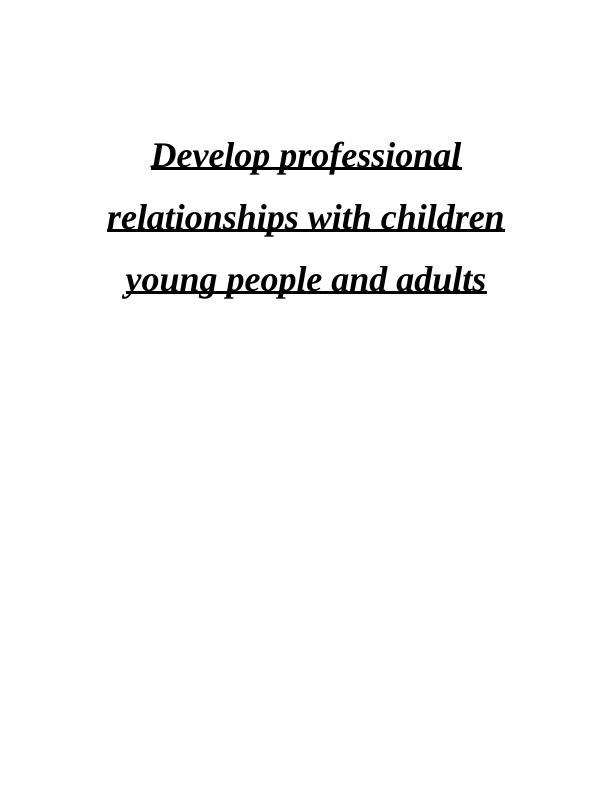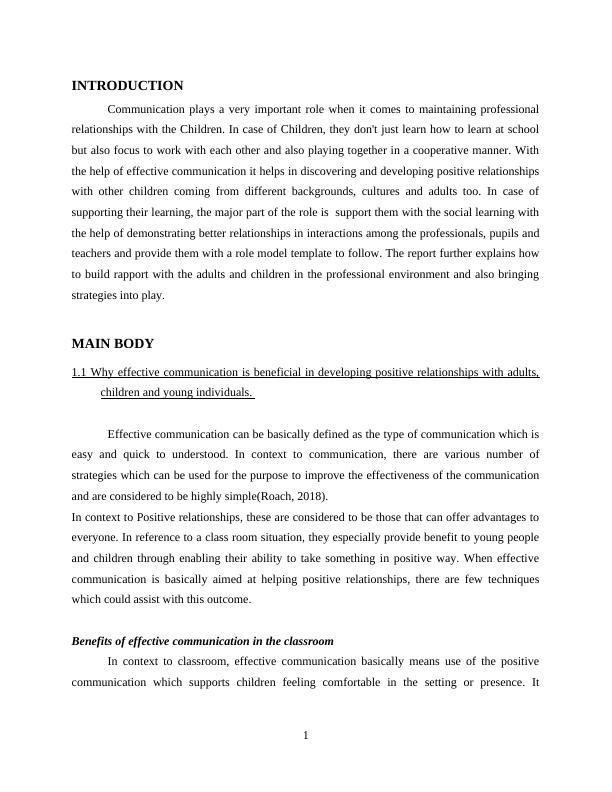Develop Professional Relationships with Children, Young People and Adults
Added on 2023-06-10
11 Pages2983 Words212 Views
Develop professional
relationships with children
young people and adults
relationships with children
young people and adults

Table of Contents
INTRODUCTION ..........................................................................................................................1
MAIN BODY...................................................................................................................................1
1.1 Why effective communication is beneficial in developing positive relationships with
adults, children and young individuals. .................................................................................1
1.2 Explain how different social, professional and cultural backgrounds might affect the
relationships and the way individuals communicate..............................................................2
1.3 Ways in which practitioner can maintain and build professional relationship with the
adults, children and young people. ........................................................................................3
1.4 How barriers to professional relationship can be overcome............................................3
2.1. Summarise the main points of legislation and procedures covering confidentiality, data
protection and the disclosure of information..........................................................................4
2.2. Explain the need to reassure children, young people and adults of the confidentiality of
shared information and the limits of this................................................................................4
2.3. Discuss situations when confidentiality protocols must be breached. Include detailed
information with reasons showing how or why.....................................................................5
7.1. Explain what is meant by inclusion and inclusive practices. Include detailed information
with reasons for how or why.................................................................................................6
7.2. Identify barriers to children and young people’s participation Include detailed information
with reasons showing how or why.........................................................................................6
CONCLUSION................................................................................................................................7
REFERENCES ...............................................................................................................................8
INTRODUCTION ..........................................................................................................................1
MAIN BODY...................................................................................................................................1
1.1 Why effective communication is beneficial in developing positive relationships with
adults, children and young individuals. .................................................................................1
1.2 Explain how different social, professional and cultural backgrounds might affect the
relationships and the way individuals communicate..............................................................2
1.3 Ways in which practitioner can maintain and build professional relationship with the
adults, children and young people. ........................................................................................3
1.4 How barriers to professional relationship can be overcome............................................3
2.1. Summarise the main points of legislation and procedures covering confidentiality, data
protection and the disclosure of information..........................................................................4
2.2. Explain the need to reassure children, young people and adults of the confidentiality of
shared information and the limits of this................................................................................4
2.3. Discuss situations when confidentiality protocols must be breached. Include detailed
information with reasons showing how or why.....................................................................5
7.1. Explain what is meant by inclusion and inclusive practices. Include detailed information
with reasons for how or why.................................................................................................6
7.2. Identify barriers to children and young people’s participation Include detailed information
with reasons showing how or why.........................................................................................6
CONCLUSION................................................................................................................................7
REFERENCES ...............................................................................................................................8

INTRODUCTION
Communication plays a very important role when it comes to maintaining professional
relationships with the Children. In case of Children, they don't just learn how to learn at school
but also focus to work with each other and also playing together in a cooperative manner. With
the help of effective communication it helps in discovering and developing positive relationships
with other children coming from different backgrounds, cultures and adults too. In case of
supporting their learning, the major part of the role is support them with the social learning with
the help of demonstrating better relationships in interactions among the professionals, pupils and
teachers and provide them with a role model template to follow. The report further explains how
to build rapport with the adults and children in the professional environment and also bringing
strategies into play.
MAIN BODY
1.1 Why effective communication is beneficial in developing positive relationships with adults,
children and young individuals.
Effective communication can be basically defined as the type of communication which is
easy and quick to understood. In context to communication, there are various number of
strategies which can be used for the purpose to improve the effectiveness of the communication
and are considered to be highly simple(Roach, 2018).
In context to Positive relationships, these are considered to be those that can offer advantages to
everyone. In reference to a class room situation, they especially provide benefit to young people
and children through enabling their ability to take something in positive way. When effective
communication is basically aimed at helping positive relationships, there are few techniques
which could assist with this outcome.
Benefits of effective communication in the classroom
In context to classroom, effective communication basically means use of the positive
communication which supports children feeling comfortable in the setting or presence. It
1
Communication plays a very important role when it comes to maintaining professional
relationships with the Children. In case of Children, they don't just learn how to learn at school
but also focus to work with each other and also playing together in a cooperative manner. With
the help of effective communication it helps in discovering and developing positive relationships
with other children coming from different backgrounds, cultures and adults too. In case of
supporting their learning, the major part of the role is support them with the social learning with
the help of demonstrating better relationships in interactions among the professionals, pupils and
teachers and provide them with a role model template to follow. The report further explains how
to build rapport with the adults and children in the professional environment and also bringing
strategies into play.
MAIN BODY
1.1 Why effective communication is beneficial in developing positive relationships with adults,
children and young individuals.
Effective communication can be basically defined as the type of communication which is
easy and quick to understood. In context to communication, there are various number of
strategies which can be used for the purpose to improve the effectiveness of the communication
and are considered to be highly simple(Roach, 2018).
In context to Positive relationships, these are considered to be those that can offer advantages to
everyone. In reference to a class room situation, they especially provide benefit to young people
and children through enabling their ability to take something in positive way. When effective
communication is basically aimed at helping positive relationships, there are few techniques
which could assist with this outcome.
Benefits of effective communication in the classroom
In context to classroom, effective communication basically means use of the positive
communication which supports children feeling comfortable in the setting or presence. It
1

basically comprises of the modelling behaviour through ensuring that the communication is
positive and effective(Roesch-Marsh, 2018).
Feels comfortable and happy: In context to effective communication, it basically promotes trust
and make everyone feels comfortable and happy.
Reduces miscommunication: In context to effective communication, the positive and direct
communication supports and helps everyone to feel sure about what is happening.
Helps pupils learn how to communicate in a positive manner: In context to effective
communication, without demonstrating the right kind of behaviour in any situation, it still results
in communicating the things without having to say them in a direct manner(Black, 2020).
1.2 Explain how different social, professional and cultural backgrounds might affect the
relationships and the way individuals communicate.
When it comes to communication, most of us are much more fluent in our own primary
language also when it comes to use of body language within our primary culture. When it comes
to different ways or methods of communication, the parameters tends to change and depends
upon the situation. This is how we basically adapt whether it is to different individuals, different
roles and different scenarios. When it comes to communication, it is majorly dependent upon the
ability to produce words(Sprott, 2019).
Social situations: In context to Social situations, the communication is spontaneous and
unplanned. With the help of using good communication techniques, it helps in influencing
relationships for the purpose to remain positive, listening to others and showing respect.
Professional Situations: In context to communication, not every communication is unplanned.
In case of schools, they often have a lot of planned communication in the formal settings and
also involves the unplanned type. Moreover, not all the communication is direct or verbal(Kerr,
and Gahm, 2018).
2
positive and effective(Roesch-Marsh, 2018).
Feels comfortable and happy: In context to effective communication, it basically promotes trust
and make everyone feels comfortable and happy.
Reduces miscommunication: In context to effective communication, the positive and direct
communication supports and helps everyone to feel sure about what is happening.
Helps pupils learn how to communicate in a positive manner: In context to effective
communication, without demonstrating the right kind of behaviour in any situation, it still results
in communicating the things without having to say them in a direct manner(Black, 2020).
1.2 Explain how different social, professional and cultural backgrounds might affect the
relationships and the way individuals communicate.
When it comes to communication, most of us are much more fluent in our own primary
language also when it comes to use of body language within our primary culture. When it comes
to different ways or methods of communication, the parameters tends to change and depends
upon the situation. This is how we basically adapt whether it is to different individuals, different
roles and different scenarios. When it comes to communication, it is majorly dependent upon the
ability to produce words(Sprott, 2019).
Social situations: In context to Social situations, the communication is spontaneous and
unplanned. With the help of using good communication techniques, it helps in influencing
relationships for the purpose to remain positive, listening to others and showing respect.
Professional Situations: In context to communication, not every communication is unplanned.
In case of schools, they often have a lot of planned communication in the formal settings and
also involves the unplanned type. Moreover, not all the communication is direct or verbal(Kerr,
and Gahm, 2018).
2

End of preview
Want to access all the pages? Upload your documents or become a member.
Related Documents
Importance of Effective Communication to Develop Positive Relationshiplg...
|14
|4878
|50
CHCECE001 - Develop cultural competencelg...
|22
|6604
|460
TDA 3.1: Communication and professional relationshipslg...
|5
|1521
|391
Teaching Assistant Level 3: Learning Experience and Utilization of Theorieslg...
|7
|1665
|87
Inclusive Practice in Childcare: Providing Equal Learning Opportunities for All Childrenlg...
|9
|2115
|323
Communication and Professional Relationships with Children, Young People & Adultslg...
|17
|5044
|159